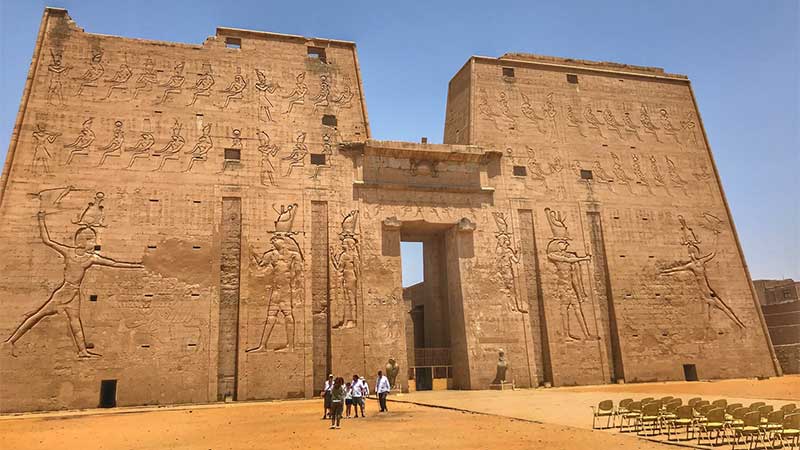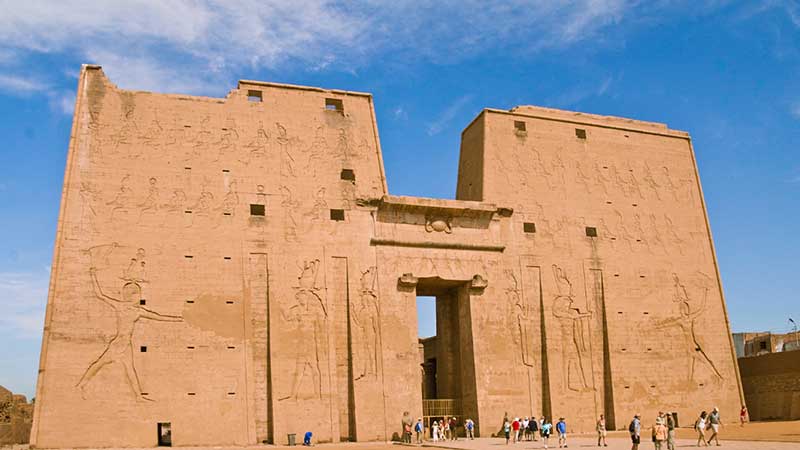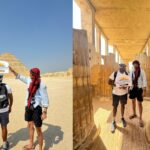Welcome to a journey through time as we delve into the captivating realm of the Temple of Edfu, located next to Temple of Kom Ombo.
Situated along the banks of the Nile River, this ancient marvel stands as a testament to the rich heritage and architectural brilliance of ancient Egypt.
In this comprehensive guide, we will unravel the mysteries of the Temple of Edfu, exploring its history, architecture, significance, and the intriguing myths that enshroud it.
Temple of Edfu : A Glimpse into the Past
The Temple of Edfu, often called the “Temple of Horus,” is a grand tribute to Horus, the falcon-headed god and one of the most significant deities in Egyptian mythology.
Carved out of sandstone, the temple’s imposing façade and intricate hieroglyphics offer a mesmerizing glimpse into the beliefs and rituals of ancient Egyptians.

Unveiling the Magnificent Architecture
The temple’s architecture is a true marvel, showcasing the prowess of ancient Egyptian builders. The Temple of Edfu is a prime example of Ptolemaic-era
design and engineering with its monumental pylons, expansive courtyards, and meticulously adorned chambers. The hypostyle hall, decorated with towering
columns, is a sight to behold, transporting visitors to an era of grandeur and luxury.
Significance and Spiritual Importance
The Temple of Edfu held immense religious significance in ancient Egypt. It was a sacred site dedicated to the veneration of Horus,
embodying divine protection and power. Pilgrims and devotees flocked to this temple to seek blessings, perform rituals, and connect
with the sacred. The temple’s inscriptions and reliefs provide insights into the religious practices and ceremonies of the time.
Legends and Myths: The Battle of Horus and Seth
Among the many captivating myths, the Battle of Horus and Seth is a cornerstone of Egyptian mythology. This epic tale narrates
the fierce rivalry between Horus, the rightful heir to Osiris’ throne, and Seth, his treacherous uncle. The temple’s decorations depict
this mythological conflict, immortalizing the triumph of good over evil.
Exploring the Temple Complex
- Pylon Entrance and Courtyard: Step through the towering pylon entrance adorned with intricate carvings and enter the expansive courtyard where priests and worshippers once gathered.
- Hypostyle Hall: Marvel at the grandeur of the hypostyle hall, with its towering columns and detailed reliefs that depict ancient rituals and offerings.
- Sanctuaries: Discover the inner covers dedicated to Horus, featuring sacred altars and hidden chambers where ceremonies were conducted in utmost secrecy.
- Nilometer: Explore the fascinating Nilometer, an ancient device used to measure the Nile’s water levels—a vital task for predicting agricultural abundance.
- Sacred Lake: Delve into the serene ambiance of the holy lake, where purification and symbolic rituals take place, enhancing the temple’s spiritual aura.
- Processional Routes: Trace the footsteps of ancient processions along the temple’s carefully planned routes, reliving the pomp and grandeur of festive ceremonies.
Preservation Efforts and Modern Discoveries
Thanks to dedicated restoration and preservation efforts, the Temple of Edfu has been saved from the ravages of time. Today, visitors can witness
the temple’s splendor and gain insights into the meticulous restoration techniques that have brought it back to life.

FAQs about the Temple of Edfu
When was the Temple of Edfu built?
The construction of the Temple of Edfu began during the Ptolemaic period, around 237 BC, and was completed during the reign of the Roman emperor Augustus.
How long did it take to build the temple?
The construction of the Temple of Edfu spanned several decades, with various phases of building and decoration. It was completed over approximately 180 years.
What is the significance of the falcon-headed god Horus?
Horus was a prominent deity in ancient Egyptian mythology, symbolizing protection, kingship, and divine rule.
The Temple of Edfu was dedicated to Horus and served as a center for his worship.
Can visitors enter the temple’s inner sanctuaries?
While visitors can explore many areas of the temple, access to the innermost sanctuaries is restricted to authorized personnel
only to preserve their historical and religious importance.
What role did the Temple of Edfu play in ancient Egyptian religious practices?
The Temple of Edfu served as a sacred space for religious ceremonies, rituals, and offerings dedicated to Horus. It was believed to
be a place of divine connection and a conduit between the mortal world and the realm of gods.
Are any annual celebrations or events held at the Temple of Edfu today?
Yes, the Temple of Edfu continues to be a celebration site. The most notable event is the “Feast of the Beautiful Meeting,” reenacting the
mythical marriage between Horus and Hathor, held in February.
Conclusion
The Temple of Edfu is an awe-inspiring testament to ancient Egypt’s ingenuity, devotion, and artistic brilliance. Its majestic architecture,
rich symbolism, and enduring myths make it a must-visit destination for history enthusiasts, spiritual seekers, and curious travelers.
As we traverse the corridors of time within this temple, we are reminded of the profound connection between human aspirations and the divine.




